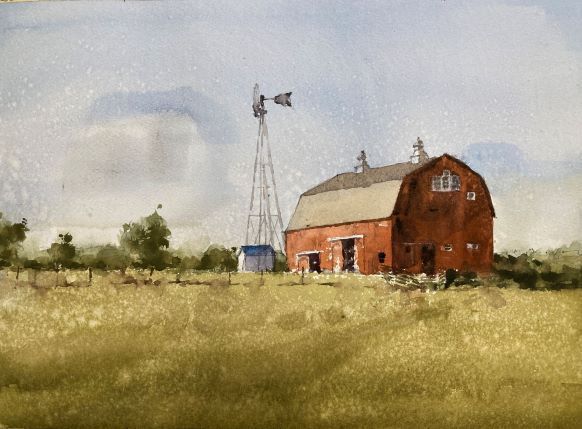Easy Steps to Create a Painting
I had a good session painting a barn watercolor this week. Starting with a value study is a great path to a successful painting. I chose to do a watercolor painting of this old barn as it had clear areas of different values that show the form and make the scene look three dimensional. This was a session on values so there wasn’t much finesse in the final study we did. My painting hand was itching to have another go at it so I did a quick sketch this afternoon. A watercolor barn is a great subject for learning how values create form with paint. If you’re looking for watercolor painting ideas it’s a good place to start.
This was never going to be a finished piece as the paper was a bit damaged where the printer ink got smeared on it which actually frees you up a bit as it’s not as precious. Quite happy with this. If I were to do it again I’d take a little more care on the sky and tone down the blue a little. I was trying to cover up the nasty smear but to no avail.
Below I outline what we did in the lesson:
First a Value Study
We started by practicing mixing up values. Knowing how to mix the right consistency of paint for a middle value is one of the most valuable skills to have. With watercolor it’s pretty much impossible to know how the paint will look just by looking at a mix on the palette. We have to judge by the consistency of the paint and it takes a bit of practice. Well worth it though. We used pretty much 3 values to paint this value study. The forms and the light are all there and it reads well visually. We’re good to go with the color version!
How not to paint a barn watercolor
This was me demonstrating how I used to paint before I discovered how important values are. I’ve pretty much identified the colors – sky blue, grass green, barn red – but none of the values are right. The sky is too dark, the grass too light and there’s no difference between the light and the shadow side of the barn.
Values First – Color Second
Where I went wrong is that I focused too much on color and not enough (if at all) on value. If the value is right then you have a lot of leeway with the color. The next version paid much more attention to the value.
This was our final study of the day. Keeping the areas pretty simple but really trying to nail the values. The sky is still blue but much paler. The grass is now a much more realistic green and now a darker value. The shadow side of the barn has a much better contrast with the light side and shows the form.
Everyone did really well with this. This is a beginner’s class so people are very new to watercolor. It’s a lot to take in but so fundamental and rewarding when it works.
I always enjoy it when I do a barn painting. A scene out in the country with farm buildings is always a pleasure for a watercolor artist. If there’s a wall or a fence around to include so much the better. It’s true that a barn painting like this is not the most original of subjects but it’s great for teaching and has a timeless quality that is always a pleasure.
Demo Video Available
I have a number of real-time demo videos on my youtube channel (and you can access them from this site here).
A similar barn painting (also part of a lesson) can be watched below:

Online Watercolor Classes
I run weekly watercolor classes regularly. If you would like to join me please check out my teaching page.
Available Original Barn Art
The original painting is also available from ugallery who are offering a number of my paintings online




Really interesting. Have not heard of “values” studies before, but they clearly make a difference! Is it something you developed ? I ask as I understand you’re a former scientist, and it.seems a methodical way to approach the problem (I’m an applied mathematician, and it certainly appeals to me!)
So value studies are pretty standard so I can’t claim any kudos sadly. Not everyone recommends them or does them though. I have only recently started using them seriously but they really help you get to a successful painting.